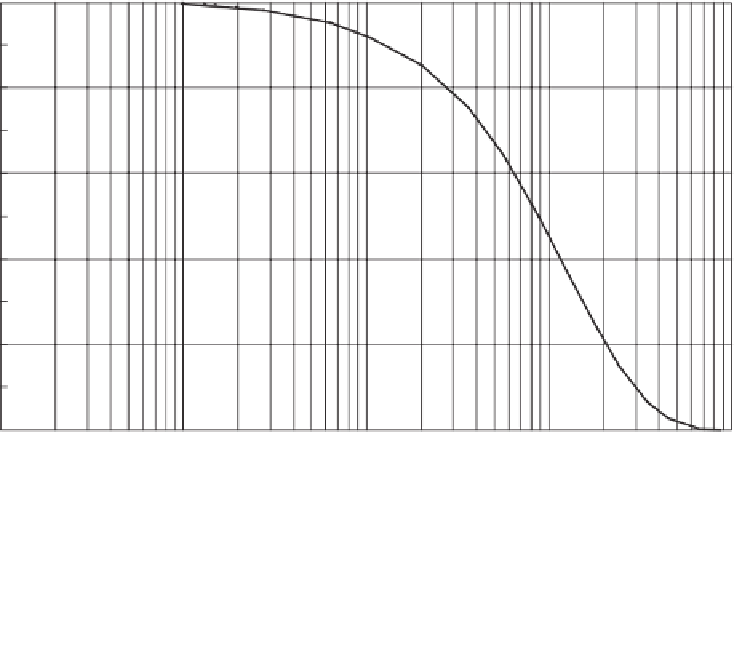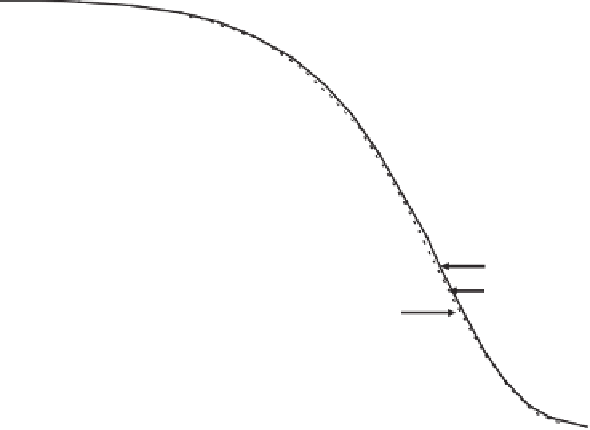Environmental Engineering Reference
In-Depth Information
T
K
=
absolute temperature [i.e.,
T
K
=
273
.
15
+
T
(K)],
common interest in geotechnical engineering correspond to
high-relative-humidity values.
temperature,
◦
C,
T
=
v
w
0
=
specific volume of water or the inverse of the den-
sity of water (i.e., 1
/ρ
w
),
m
3
/kg,
4.2.2 Components of Soil Suction
Soil suction can be quantified in terms of the relative humid-
ity immediately adjacent to the water surface and is called
“total suction.” There are two primary components to soil
suction, namely, matric
*
and osmotic suction. There also
appears to be a component of soil suction related to the
adsorptive forces associated with water and a solid surface
(Yong and Warkentin, 1966). However, it is difficult to iso-
late and quantify the adsorptive component of suction. It
has been possible to formulate solutions for most geotechni-
cal engineering problems through use of matric suction and
osmotic suction, recognizing the sum of the two components
as total suction.
Total, matric, and osmotic suctions can be defined as fol-
lows (Aitchison, 1964):
density of water (i.e., 998 kg/
m
3
ρ
w
=
at temperature
20
◦
C),
T
=
ω
v
=
molecular mass of water vapor (i.e., 18.016 kg/
kmol),
u
v
=
partial pressure of pore-water vapor
,
kPa, and
u
v
0
=
saturation pressure of water vapor over a flat sur-
face of pure water at the same temperature, kPa.
The reference state for quantifying the components of suc-
tion is the vapor pressure above a flat surface of pure water
(i.e., water with no salts or impurities). The relative vapor
pressure in the air immediately adjacent to the water,
u
v
0
,
is called relative humidity (
h
r
or RH, %). If we select a ref-
erence temperature of 20
◦
C, the constants in Eq. 4.1 give
a value of 135,022 kPa. Equation 4.1 can now be written as
a fixed relationship between total suction in kilopascals and
relative vapor pressure:
u
v
/
Matric or capillary component of free energy:
Matric suc-
tion is the equivalent suction derived from the mea-
surement of the partial pressure of the water vapor in
equilibrium with the soil-water relative to the partial
pressure of the water vapor in equilibrium with a solu-
tion identical in composition with the soil-water.
Osmotic (or solute) component of free energy:
Osmotic
suction is the equivalent suction derived from the mea-
surement of the partial pressure of the water vapor in
equilibrium with a solution identical in composition
135
,
022 ln
u
v
u
v
0
ψ
=−
(4.2)
Figure 4.1 shows a plot of Eq. 4.1 for three different tem-
peratures. Soil suction
ψ
approaches zero when the relative
humidity (i.e.,
u
v
0
) is equal to 100%. A relative humid-
ity value less than 100% in a soil indicates the presence of
suction in the soil. Figure 4.1 also shows that suction can
become extremely large. For example, a relative humidity
of 94.24% at a temperature of 20
◦
C corresponds to a soil
suction of 8000 kPa. The range of soil suctions of most
u
v
/
*
The spelling of the term “matric” is in accordance with the recommenda-
tion of the Committee on Terminology of the Society of Soil Science of
America. The definition is from their
Glossary of Soil Science Terminology
(1963, 1970, and 1979).
100
80
60
40
T
= 30
°
C
T
= 20
°
C
T
= 10
°
C
20
0
10
6
100
1000
10,000
100,000
Total suction,
ψ
(kPa)
Figure 4.1
Thermodynamic equilibrium between relative humidity and total suction.



















Search WWH ::

Custom Search